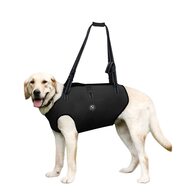|
Rabbits are hopping into homes and hearts more than ever in recent years, and it’s important that pet parents know how to safely handle and pick them up. Bunnies, like all small pets, can be easily injured without proper support. Once you understand the basics, you and your bun will have everything you need to be as inseparable as any other pet parent and their furry friend.
Here's how to pick up a rabbit without scaring or injuring them. How to Hold a Rabbit 1. Gather Your Rabbit To get started, find a safe area to handle your rabbit. Starting on the floor is the safest choice, in an area with no obstacles (nothing to knock over or break) and preferably a blanket, rug, or carpeting to soften any impacts should your rabbit break loose. With your area set, lure your rabbit with treats so they can get used to your setup and settle in. 2. Pet the Rabbit To hold a rabbit, you must touch under their belly and under their rump. As prey animals, rabbits can be skittish by nature and may hop, thump, or run if you try to touch their belly or back end. To help your rabbit prepare for being picked up, begin by petting areas they’re used to (such as along the back and scruff) and slowly introduce your petting to new areas, like behind their back legs, under their chest, and on their belly. At this stage, don’t lift them up yet—just see how your bunny reacts to being touched. If they startle badly, repeat this step for as long as it takes for them to get used to you touching the necessary areas. 3. Pick Up Your Rabbit When you and your rabbit are ready, it is best to settle next to your rabbit, either behind or to their side. Scoop one hand under their chest, and another under their back legs or rump, drawing them into your lap or chest as you do so. You want to do this swiftly, though not rushed, and with confidence. If your rabbit startles or tries to jump, hold them firmly to your body for their comfort and safety. A rabbit will only feel safe being held if they:
Bunnies, like all small pets, can be easily injured without proper support.Depending on how you are sitting or standing when holding a rabbit, it may be more secure to hold your rabbit’s chest and shoulders from the side or above. You may also hug them into your body, under their back legs, or the classic hold of under both the chest and rump. The hand at the front of the rabbit should span underneath and to the side or top of the shoulders to provide better control.
1 Comment
 Old dogs often experience a decline in their physical abilities and health, which can impact their ability to keep up on walks and necessitate extra special care. This change is a natural part of the aging process in dogs, just as it is in humans. According to VCA Hospitals: Small dogs are considered senior citizens of the canine community when they reach 11-12 years of age. Their medium-sized friends become seniors at 10 years of age. Their larger-sized colleagues are seniors at 8 years of age. And, finally, their giant-breed counterparts are seniors at 7 years old. Here are several reasons why older dogs might struggle with walks and require more attention: 𝐉𝐨𝐢𝐧𝐭 𝐏𝐫𝐨𝐛𝐥𝐞𝐦𝐬: One of the most common issues in older dogs is arthritis, a condition that causes joint pain and stiffness. This can make it difficult and painful for them to walk, run, or even stand. Regular, gentle exercise can help, but care must be taken not to overexert an arthritic dog. 𝐃𝐞𝐜𝐫𝐞𝐚𝐬𝐞𝐝 𝐒𝐭𝐚𝐦𝐢𝐧𝐚 𝐚𝐧𝐝 𝐌𝐮𝐬𝐜𝐥𝐞 𝐌𝐚𝐬𝐬: As dogs age, they naturally lose some of their stamina and muscle mass. This decline can make it hard for them to keep up on longer walks. Older dogs may tire more quickly and need shorter, more frequent walks instead of long excursions. 𝐒𝐞𝐧𝐬𝐨𝐫𝐲 𝐃𝐞𝐜𝐥𝐢𝐧𝐞: Aging can also affect a dog's senses. Loss of hearing and vision can make walks more challenging and potentially frightening for an older dog. They may become more anxious or hesitant, especially in unfamiliar or busy environments. 𝐂𝐡𝐫𝐨𝐧𝐢𝐜 𝐇𝐞𝐚𝐥𝐭𝐡 𝐈𝐬𝐬𝐮𝐞𝐬: Older dogs often have chronic health issues such as heart disease, kidney disease, or other conditions that can affect their energy levels and overall health. These conditions may require specific care routines and can limit the amount and intensity of exercise they can safely handle. To care for an older dog, it's important to adapt to their changing needs. Suggestions:
Do Dogs Know We Love Them? By: Janelle Leeson. Reviewed by Barri J. Morrison, DVM on Jan. 29, 20242/15/2024 While you may shower your pup with verbal affection, toys, and cuddles, a nagging uncertainty might linger—does your dog know you love them? Actions tend to speak louder than words. However, recent research suggests that the sentiment behind verbal expressions of love may not be entirely lost on your furry friend. That said, every pup has their own love language. By using any of the following tips, you can show love to your furry friend. Do Dogs Know We Love Them? Belly rubs, games of fetch, daily walks, nutritious meals… The ways you care for your pup convey a sense of love that domesticated dogs can comprehend. While it might not be the same love that humans understand, the genuine bonds between dogs and humans remain. While some dogs may experience love at first sight, many require time to develop a strong bond, much like any other deep connection in our lives. Rescue dogs, in particular, may need several days, weeks, or even months to understand that you love them. Most dogs can’t say “I love you” (at least without the help of talking dog buttons), but they express love through body language, such as a happy tail, perky ears, and loving licks. Scientists also say that the signs of love are apparent in dog and human biochemistry, since we both get a surge of happy chemicals at the mere sight or sound of the other. As for those who doubt that dogs love us in return, this is precisely what neuroscientist Gregory Berns aims to explore through brain-imaging and behavioral experiments. “I think the answer is yes. [Dogs] love us for things far beyond food—basically the same things that humans love us for; things like social comfort and social bonds,” he tells his colleagues at Emory University. How To Show Your Dog You Love ThemLike humans, dogs have their own love language for expressing and receiving affection. Next time you want your pup to feel loved, try one of these affectionate gestures. 1. Communication Acts of love are important, but don’t underestimate the power of telling your dog you love them, especially in a sing-song, cheerful tone, according to NPR. Berns found that when given the choice of food or verbal praise from their beloved human, nearly every dog in his study opted for praise. “We know how it feels when someone praises us; there’s a positive feeling associated with it,” he says. “That’s perhaps similar to what dogs are feeling.” Dogs with close human relationships also respond positively to their human’s gaze, often approaching them or pawing at them for pets. Just keep in mind that hard stares can be threatening in dog speak, so use gazing in moderation and only with pups you’ve established a positive relationship with. 2. Treats Of course, we all know the saying that the way to a pup’s heart is through their stomach, and there’s still plenty of truth in that. Consider loveable Ozzie: He’s a short-haired terrier mix who participated in Bern’s study. He chose treats over his human’s praise 100% of the time. While an outlier in this study, Ozzie isn’t the only pup who enjoys treats from his humans. Experts say high-quality training treats should be on every pet parent’s shopping list. “There is nothing more bonding than using rewards to train your pup. Dogs get to do the three best things in the world: be with you, learn a behavior, and eat all at the same time,” says Dr. Gary Weitzman, veterinarian and president and CEO of the San Diego Humane Society. 3. Food Your dog wants to know they can count on you. A good way to accomplish that? To feed them nutritious meals on a set schedule. In fact, dogs thrive when they have a routine, from meals, walks, and even potty breaks and bedtime. Overfeeding pups is often confused as showing love, but it’s keeping them at an ideal weight that’s the ultimate gesture of caring for and loving your pooch. 4. Respect When it comes to cultivating a strong bond with our pets, respecting them is one of the most important things we can do. One study suggests that mutual respect in dog-human relationships fosters trust, a sense of security, and even increased dependency within the relationship. The same study goes as far as saying that recognizing and respecting our dog’s boundaries brings many pet parents the fulfilling realization that they are genuinely meant to be their dog’s caretaker.
5. Scratches, Rubs, and Pats For dogs who cherish physical contact, a gentle pat, ear scratch, or belly rub serves as a heartfelt “I love you.” Not all dogs are fond of being touched, just as there are humans who don’t appreciate the gesture. However, if your dog is constantly in your space, lying on or next to you, or wiggles their entire body at the mere sight of you, it’s a good indication they’ll appreciate more physical affection. Even brief interactions with their human companions (as little as three minutes) can elevate oxytocin levels and reduce stress levels in dogs. Those doing the petting are likely to experience the same mood-boosting effects. The best areas to pet, scratch, or rub a dog typically include:
Because dogs can’t communicate verbally, closely watch their body language to gauge comfort. Look for changes in ear position, gaze, body posture, and facial expressions. If a dog moves away from your outstretched hand or during physical contact, respect their request not to be touched. Where you pet, rub, or pat matters too. Most dogs don’t enjoy being touched on or near their:
6. Play Play can look different for every dog, especially as puppies grow into adults and eventually settle into their senior years. So, try a variety of toys that keep your dog active and mentally engaged. Hunter recommends tug-of-war toys and puzzles or games that turn mealtimes into treasure hunts. “Mental activities are a great way to bond with your pet,” says Hunter. “Dogs thrive on attention, and you may even find your dog returning the favor by being more attentive to your cues.” Without interactive play with their cherished humans, dogs can become bored, potentially leading to destructive behaviors and, in some cases, depression. 7. ExerciseWhen you participate in activities like walking, swimming, or practicing agility with your dog, you’re not just providing opportunities for new experiences; you’re demonstrating love and strengthening the bond with your canine companion. According to the American Veterinary Medical Association (AVMA), exercise, particularly outdoor exercise, is a critical opportunity to stimulate a dog’s brain with a variety of sights, smells, and sounds. Regular physical activity is vital for maintaining your dog’s muscle tone and joint mobility, as well as your own. Exercise can be serious business for your pup, so before gearing up your dog for more strenuous activities, such as flyball or hikes, consult your veterinarian to make sure your pet is in good health. Your vet will also discuss any necessary precautions, ensuring that your dog’s love for movement aligns with their overall well-being. Ways To Show Your Dog You Love Them FAQs How do dogs say I love you?Pups who like to tell you that they love you may lick, exuberantly wag their tail, and even boast a broad smile. Love is also evident in your pup’s daily activities and subtle gestures. They may stay close during playtime, display a keen sensitivity to your emotions, or consistently show eagerness to join you in new adventures. How do you make your dog feel safe?Establish a consistent daily routine that your dog can count on. Dogs thrive when they know what to expect, and knowing that you’ll serve them breakfast just after their morning walk and that they’ll get their favorite chew toy just before you leave for work will make their day and yours go much smoother. Never physically or verbally punish your dog, as it only fosters fear and can lead to reactive behavior. Instead, stick to positive reinforcement training, which teaches your dog desired behavior with reward-based learning while strengthening your bond. Featured Image: LittleBee80/iStock / Getty Images Plus via Getty Images WRITTEN BY Janelle Leeson Freelance Writer |
Archives
July 2024
Categories |


 RSS Feed
RSS Feed